"If you pull the release lever and push the seat forward really hard, it should move a little bit," replied Sung Kang, one of the owners of the Z and the actor who played Han from the Fast and Furious films.
Unfortunately, I need more than a little travel from the driver's seat rails. Sung stands at 6 feet and I'm 5'9" according to my driver's license. Okay, I'm 5-foot 8.5 inches IRL, but who doesn't round up? Between how low the CarbonSignal seats were mounted to the floor and the amount of clearance between the soles of my Jordan 1s and the factory pedals, I felt like a kid sneaking into pa's car for the first time. I yanked the handle below my bum and heaved as hard as I could. Voila! I managed to eek an inch or so forward, just enough to reach the pedals.
My reward for being barely tall enough was the glorious vista of a rare, smog-free Los Angeles from the San Gabriel Mountains. I fired up the Z's ignition and any inferiority complexes I was struggling with quickly warbled away from the drone of the HyTech headers and GReddy exhaust. This ivory beast was loud.
Notched into first gear, I let out the OS Giken twin-plate clutch – a strenuous act that once again made me question my manliness – and the cabin grew louder as positive momentum began. Every pebble, particle, and loose piece of mountain road pinged the Datsun's undercarriage, amplified by a chassis that's been stripped and restored sans any sound deadening material. The Z was a road-going percussion instrument.

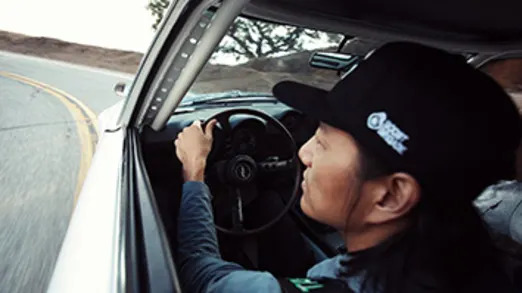


Fugu Z Rises
The 240Z wasn't always this loud. In fact, up until February of last year, the Datsun lived its 40-plus years in an unmodified state. Sung Kang and his friends Michael Jen and Greg Hwang's search for a clean, stock first-generation Z lead them to a brown specimen owned found in the high desert, 70 miles north of Los Angeles. And that's when a modest Datsun 240Z began its transformation into the machine I was driving, the Fugu Z.
"That stuck with me when we started thinking of a proper name for our Z," continued Kang. "I remembered having dinner with Sonny Chiba in Japan while filming Tokyo Drift. We were having fugu, Japanese for blowfish, and Chiba explained that if the poisonous fish wasn't properly prepared, it could kill you – a parallel I saw with a car built for the track."
Despite the exotic moniker, the original intent of the Fugu Z was a humble one. Kang and his friends set out to buy a car they could have fun restoring and drive on weekend track days or canyon runs. It was supposed to be an outlet for friends who shared a love for cars. But thanks to social media, things got a little out of hand.
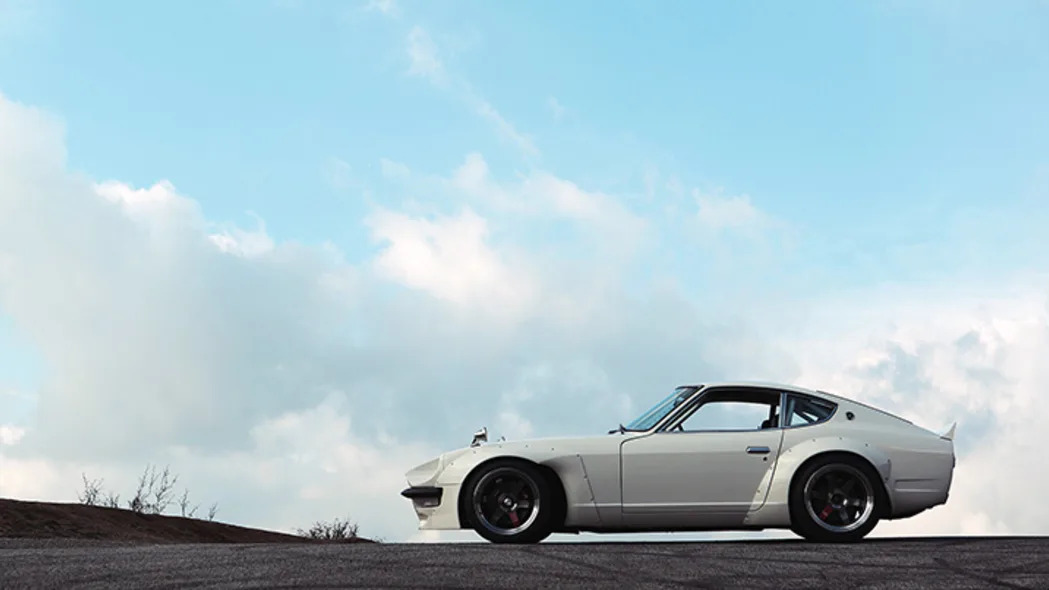
Kang was looking for a body kit and stumbled across an image of one on the interwebs he liked. It was a widebody made by Rocket Bunny, a brand big in Japanese Domestic Market (JDM) circles. Sung published a feeler Instagram post asking where he could source one.
"I'm not an aftermarket aero kind of guy, I normally appreciate cars for their original form," said Kang. "But since we wanted to track the car, we needed bigger fenders to fit wider tires. I Googled for days, searching for 240Z fender flares and widebody kits, and when I stumbled across the image of the Rocket Bunny, I had an immediate visceral reaction to it. It was curvy, red, and looked incredibly sexy. We needed to get this kit."
Which is where aftermarket parts manufacturer GReddy got involved. A legend in the tuning game, GReddy's stateside presence dates back to 1994. The company has not only managed to weather a few economic downturns, it's managed to stay relevant in an industry that changed drastically in the last 22 years. Besides peddling hard parts and electronics, GReddy expanded into motorsports, managing a Scion drift racing program. In the most recent 2015 Formula D season they finished second overall with Ken Gushi piloting the GReddy-built-and-prepped FR-S. They also picked up the rights to distribute Rocket Bunny body kits in the US.
GReddy's marketing manager saw Kang's Instagram post and responded. Direct messages between the two led to meetings with the company president Kenji Sumino and eventually brought the build of the entire project to GReddy's headquarters in Irvine, CA. After constructing a competitive drift car, building a vintage Datsun was well within their abilities. But like any market-savvy company, GReddy also saw opportunity for promotion.
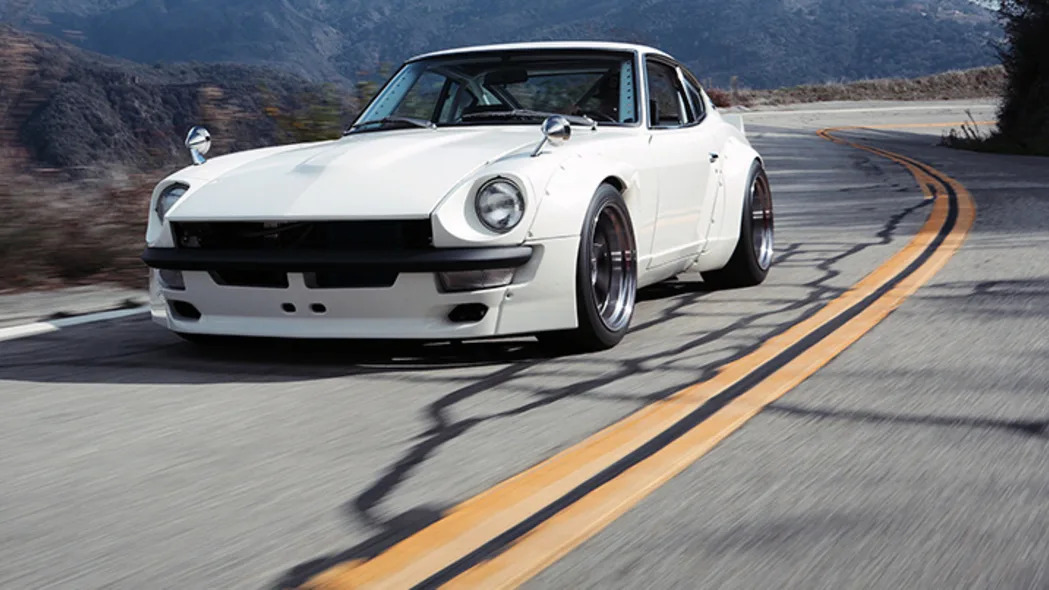
If they were going to build the Fugu Z, why not document the Fugu Z build with a short video series for Kang's Facebook page? If they were going to debut the build, why not do it at the SEMA Show, the largest automotive aftermarket trade event in the world? And if they were going to haul the Fugu Z to the Las Vegas Convention Center, why not enter it into the Gran Turismo Awards?
An annual competition held during the SEMA Show, the Gran Turismo Awards celebrates the pinnacle of aftermarket car building. Awards are doled out to five categories (Asian Import, Domestic, Euro, Hot Rod, and Truck/SUV) by an expert judge from each respective field, and one Best in Show is crowned from the five. GReddy is familiar with the contest, taking home three Best Asian Import trophies since 2003 but never winning the top prize. Although a category award offers prestige, Best in Show brings with it digital immortalization. The overall winner is modeled into the Gran Turismo video game and becomes a playable vehicle. With the Fugu Z, Sumino and the GReddy team finally grabbed overall honors, taking the Best in Show nod from GT franchise creator Kazunori Yamauchi himself.
"Having a car that you built appear in Gran Turismo has to be the biggest honor for a car builder," said Sumino. "We knew we had a good chance of winning with the Fugu Z – it was a full build from the ground up, our restomod approach was unique, and it being the vision of an actor from the Fast and Furious films gave it a compelling story. But when we found out we won, I was in shock. I still can't believe people will be able to drive a car our team helped build in a video game."
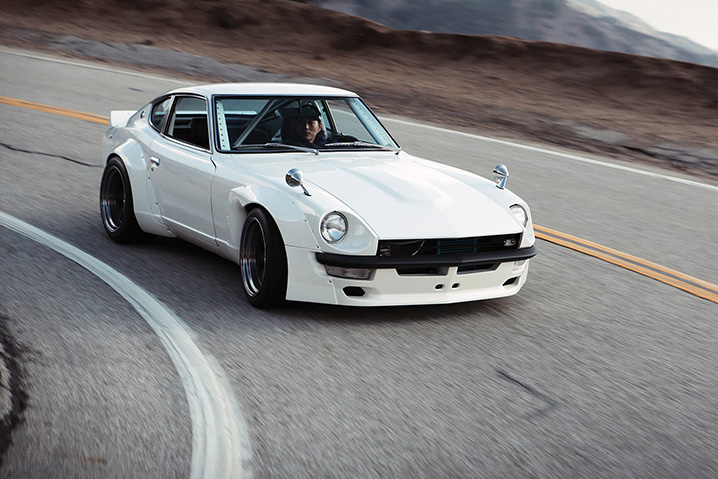
Furious and Fast
Back in the San Gabriel Mountains I babied the accelerator, acclimating to the cacophony of the Z and my seating position. After a few turns I felt more comfortable and dared to squeeze more throttle. The engine, an inline-6 from an R32 Nissan Skyline GT-R, barked savagely. This RB26 motor comes without its original twin-turbo configuration, an homage to the 240Z's original naturally aspirated L24 inline-six.
With an initial tune on the AEM Infiniti ECU, the Fugu Z produced 220 hp to the wheels on GReddy's dyno. Fully sorted and running E85 fuel, the Datsun should make over 300 hp. Driving on the mountains north of L.A., the car's power was palpable. If the Fugu Z was loud at cruising state, my body quivered from the trifecta of engine, exhaust, and road noise at wide-open throttle.
Approaching a switchback, I pegged the middle pedal with my right foot. In the movie version of this drive, a slow-motion cutaway scene shows the Wilwood brake calipers cinch the discs behind the lightweight 17-inch Volk TE37V forged aluminum wheels. The grippy Nitto NT01 tires chirp as the car slows. Reality snaps me back from delusions of being cast in Fast 8 as I rotate the four-decade-old steering wheel and felt the Z's weight transition as I turned in.

For a car that rolled off the production line before any of the Star Wars flicks, the chassis is remarkably rigid. Credit goes to thousands of strategic spot welds and a roll cage fabricated by Ben Schwartz at GReddy. I rolled on the throttle at the corner exit, imagining the RB26's individual throttle bodies sucking in air through its six shiny new velocity stacks. This time when the explosion of sounds hit, it was all thrills.
After twenty minutes of driving on the peaks above Los Angeles, I spotted a turnout perfect for static photography, just in time to catch the last rays of the sun. I parked the Datsun and grabbed my Canon DSLR with arms trembling with fatigue from the car's unassisted steering. I've seen the Fugu Z a handful of times before, but it still gave me pause: this thing is beautiful. With the Rocket Bunny bodywork and a fresh coat of period-correct Kilimanjaro White paint (applied by Signature Autobody in Orange, CA), I couldn't find a bad angle on the car.
With twilight fast approaching, Kang took the wheel and I jumped in the passenger seat for the ride back to L.A. "What's next for the Fugu Z?" I yelled, barely audible over the roar in the cockpit. "Well," Kang paused. "Michael, Greg and I never expected any of this to happen ... SEMA, Gran Turismo Awards, or Jay Leno's Garage." The Fugu Z garnered so much buzz from SEMA that Leno's people requested the car for an upcoming taping of his web series.
"Originally, the Z was supposed to be something my friends and I could have fun with, a hobby," explained the actor. "But as the build got underway and I got to really know Kenji, Ben, Aaron and everyone else from GReddy, and the other passionate people from around the world who rallied to help build the Fugu Z, the project took a life of its own. The ethos of why the Fugu Z came to be is still there, only we casted a wider net in terms of friends."
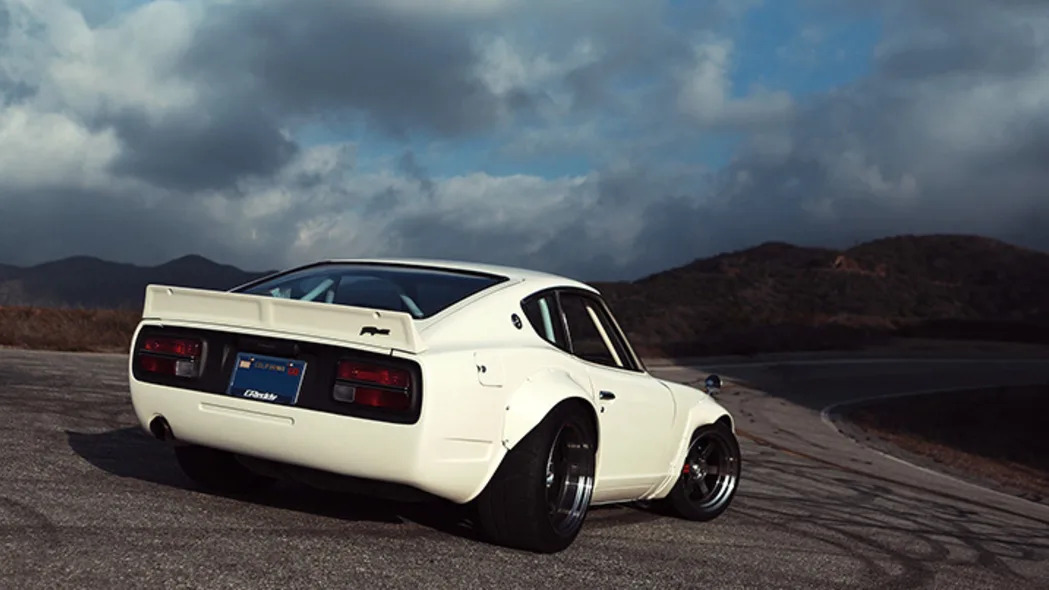
"It took a village to build the Fugu Z and I appreciate all the time, dedication and love everyone put into," continued Kang. "Any press we get is to shine a light on all of their hard work. They are the ones who brought the Fugu Z to life. For me, I'm just waiting until the car is done having to stay pretty so we can go take it out and whip it around the track." Spoken like a true car guy.
Kang braked and downshifted the 5-speed RB25 transmission approaching a hairpin turn. I turned off the voice recorder app and shoved the iPhone back into my pocket. Kang cleared the apex of the corner, glanced at my empty hands, smirked, and pounded the throttle. As the engine howled past 9,000 rpm a wave of air rushed through the windowless car doors and over my face.
I took a moment to soak in the last moments of fading light. It felt like we were in a scene of one of the Fast films – Han driving on a windy road while waxing poetic about cars. Only this was real life and I was in the passenger seat with Sung Kang, not some fictional character he played on the big screen.
Han lives. Scratch that. Long live Sung Kang. And long live the Fugu Z.
Unfortunately, I need more than a little travel from the driver's seat rails. Sung stands at 6 feet and I'm 5'9" according to my driver's license. Okay, I'm 5-foot 8.5 inches IRL, but who doesn't round up? Between how low the CarbonSignal seats were mounted to the floor and the amount of clearance between the soles of my Jordan 1s and the factory pedals, I felt like a kid sneaking into pa's car for the first time. I yanked the handle below my bum and heaved as hard as I could. Voila! I managed to eek an inch or so forward, just enough to reach the pedals.
My reward for being barely tall enough was the glorious vista of a rare, smog-free Los Angeles from the San Gabriel Mountains. I fired up the Z's ignition and any inferiority complexes I was struggling with quickly warbled away from the drone of the HyTech headers and GReddy exhaust. This ivory beast was loud.
Notched into first gear, I let out the OS Giken twin-plate clutch – a strenuous act that once again made me question my manliness – and the cabin grew louder as positive momentum began. Every pebble, particle, and loose piece of mountain road pinged the Datsun's undercarriage, amplified by a chassis that's been stripped and restored sans any sound deadening material. The Z was a road-going percussion instrument.




Fugu Z Rises
The 240Z wasn't always this loud. In fact, up until February of last year, the Datsun lived its 40-plus years in an unmodified state. Sung Kang and his friends Michael Jen and Greg Hwang's search for a clean, stock first-generation Z lead them to a brown specimen owned found in the high desert, 70 miles north of Los Angeles. And that's when a modest Datsun 240Z began its transformation into the machine I was driving, the Fugu Z.
"My friend Steve Strope is a car builder and he built some of my favorite cars, including the Anvil Mustang that appeared in Fast & Furious 6," said Kang. "I asked him why he named his cars and he said that so much goes into building one they become like his kids, and all family members should have a name."Sonny Chiba explained that if the poisonous fish wasn't properly prepared, it could kill you – a parallel I saw with a car built for the track.
"That stuck with me when we started thinking of a proper name for our Z," continued Kang. "I remembered having dinner with Sonny Chiba in Japan while filming Tokyo Drift. We were having fugu, Japanese for blowfish, and Chiba explained that if the poisonous fish wasn't properly prepared, it could kill you – a parallel I saw with a car built for the track."
Despite the exotic moniker, the original intent of the Fugu Z was a humble one. Kang and his friends set out to buy a car they could have fun restoring and drive on weekend track days or canyon runs. It was supposed to be an outlet for friends who shared a love for cars. But thanks to social media, things got a little out of hand.

Kang was looking for a body kit and stumbled across an image of one on the interwebs he liked. It was a widebody made by Rocket Bunny, a brand big in Japanese Domestic Market (JDM) circles. Sung published a feeler Instagram post asking where he could source one.
"I'm not an aftermarket aero kind of guy, I normally appreciate cars for their original form," said Kang. "But since we wanted to track the car, we needed bigger fenders to fit wider tires. I Googled for days, searching for 240Z fender flares and widebody kits, and when I stumbled across the image of the Rocket Bunny, I had an immediate visceral reaction to it. It was curvy, red, and looked incredibly sexy. We needed to get this kit."
Which is where aftermarket parts manufacturer GReddy got involved. A legend in the tuning game, GReddy's stateside presence dates back to 1994. The company has not only managed to weather a few economic downturns, it's managed to stay relevant in an industry that changed drastically in the last 22 years. Besides peddling hard parts and electronics, GReddy expanded into motorsports, managing a Scion drift racing program. In the most recent 2015 Formula D season they finished second overall with Ken Gushi piloting the GReddy-built-and-prepped FR-S. They also picked up the rights to distribute Rocket Bunny body kits in the US.
GReddy's marketing manager saw Kang's Instagram post and responded. Direct messages between the two led to meetings with the company president Kenji Sumino and eventually brought the build of the entire project to GReddy's headquarters in Irvine, CA. After constructing a competitive drift car, building a vintage Datsun was well within their abilities. But like any market-savvy company, GReddy also saw opportunity for promotion.

If they were going to build the Fugu Z, why not document the Fugu Z build with a short video series for Kang's Facebook page? If they were going to debut the build, why not do it at the SEMA Show, the largest automotive aftermarket trade event in the world? And if they were going to haul the Fugu Z to the Las Vegas Convention Center, why not enter it into the Gran Turismo Awards?
An annual competition held during the SEMA Show, the Gran Turismo Awards celebrates the pinnacle of aftermarket car building. Awards are doled out to five categories (Asian Import, Domestic, Euro, Hot Rod, and Truck/SUV) by an expert judge from each respective field, and one Best in Show is crowned from the five. GReddy is familiar with the contest, taking home three Best Asian Import trophies since 2003 but never winning the top prize. Although a category award offers prestige, Best in Show brings with it digital immortalization. The overall winner is modeled into the Gran Turismo video game and becomes a playable vehicle. With the Fugu Z, Sumino and the GReddy team finally grabbed overall honors, taking the Best in Show nod from GT franchise creator Kazunori Yamauchi himself.
"Having a car that you built appear in Gran Turismo has to be the biggest honor for a car builder," said Sumino. "We knew we had a good chance of winning with the Fugu Z – it was a full build from the ground up, our restomod approach was unique, and it being the vision of an actor from the Fast and Furious films gave it a compelling story. But when we found out we won, I was in shock. I still can't believe people will be able to drive a car our team helped build in a video game."

Furious and Fast
Back in the San Gabriel Mountains I babied the accelerator, acclimating to the cacophony of the Z and my seating position. After a few turns I felt more comfortable and dared to squeeze more throttle. The engine, an inline-6 from an R32 Nissan Skyline GT-R, barked savagely. This RB26 motor comes without its original twin-turbo configuration, an homage to the 240Z's original naturally aspirated L24 inline-six.
To compensate for the lack of boost, Bluemoon Performance (a mechanic shop in Costa Mesa, CA) and DSport magazine rebuilt the bottom end of the engine, raising the compression from 8.5:1 to 12.0:1 using CP pistons and Carrillo rods. Port Flow Design cleaned the head and replaced the valves and valve springs with Supertech parts. Engine and transmission mounts plus a driveshaft from McKinney Motorsports made the swap relatively painless, while the Techno Toy Tuning R200 rear-end conversion stuffed with an OS Giken limited-slip differential updated the driveline.I'm just waiting until the car is done having to stay pretty so we can go take it out and whip it around the track.
With an initial tune on the AEM Infiniti ECU, the Fugu Z produced 220 hp to the wheels on GReddy's dyno. Fully sorted and running E85 fuel, the Datsun should make over 300 hp. Driving on the mountains north of L.A., the car's power was palpable. If the Fugu Z was loud at cruising state, my body quivered from the trifecta of engine, exhaust, and road noise at wide-open throttle.
Approaching a switchback, I pegged the middle pedal with my right foot. In the movie version of this drive, a slow-motion cutaway scene shows the Wilwood brake calipers cinch the discs behind the lightweight 17-inch Volk TE37V forged aluminum wheels. The grippy Nitto NT01 tires chirp as the car slows. Reality snaps me back from delusions of being cast in Fast 8 as I rotate the four-decade-old steering wheel and felt the Z's weight transition as I turned in.

For a car that rolled off the production line before any of the Star Wars flicks, the chassis is remarkably rigid. Credit goes to thousands of strategic spot welds and a roll cage fabricated by Ben Schwartz at GReddy. I rolled on the throttle at the corner exit, imagining the RB26's individual throttle bodies sucking in air through its six shiny new velocity stacks. This time when the explosion of sounds hit, it was all thrills.
After twenty minutes of driving on the peaks above Los Angeles, I spotted a turnout perfect for static photography, just in time to catch the last rays of the sun. I parked the Datsun and grabbed my Canon DSLR with arms trembling with fatigue from the car's unassisted steering. I've seen the Fugu Z a handful of times before, but it still gave me pause: this thing is beautiful. With the Rocket Bunny bodywork and a fresh coat of period-correct Kilimanjaro White paint (applied by Signature Autobody in Orange, CA), I couldn't find a bad angle on the car.
With twilight fast approaching, Kang took the wheel and I jumped in the passenger seat for the ride back to L.A. "What's next for the Fugu Z?" I yelled, barely audible over the roar in the cockpit. "Well," Kang paused. "Michael, Greg and I never expected any of this to happen ... SEMA, Gran Turismo Awards, or Jay Leno's Garage." The Fugu Z garnered so much buzz from SEMA that Leno's people requested the car for an upcoming taping of his web series.
"Originally, the Z was supposed to be something my friends and I could have fun with, a hobby," explained the actor. "But as the build got underway and I got to really know Kenji, Ben, Aaron and everyone else from GReddy, and the other passionate people from around the world who rallied to help build the Fugu Z, the project took a life of its own. The ethos of why the Fugu Z came to be is still there, only we casted a wider net in terms of friends."

"It took a village to build the Fugu Z and I appreciate all the time, dedication and love everyone put into," continued Kang. "Any press we get is to shine a light on all of their hard work. They are the ones who brought the Fugu Z to life. For me, I'm just waiting until the car is done having to stay pretty so we can go take it out and whip it around the track." Spoken like a true car guy.
Kang braked and downshifted the 5-speed RB25 transmission approaching a hairpin turn. I turned off the voice recorder app and shoved the iPhone back into my pocket. Kang cleared the apex of the corner, glanced at my empty hands, smirked, and pounded the throttle. As the engine howled past 9,000 rpm a wave of air rushed through the windowless car doors and over my face.
I took a moment to soak in the last moments of fading light. It felt like we were in a scene of one of the Fast films – Han driving on a windy road while waxing poetic about cars. Only this was real life and I was in the passenger seat with Sung Kang, not some fictional character he played on the big screen.
Han lives. Scratch that. Long live Sung Kang. And long live the Fugu Z.
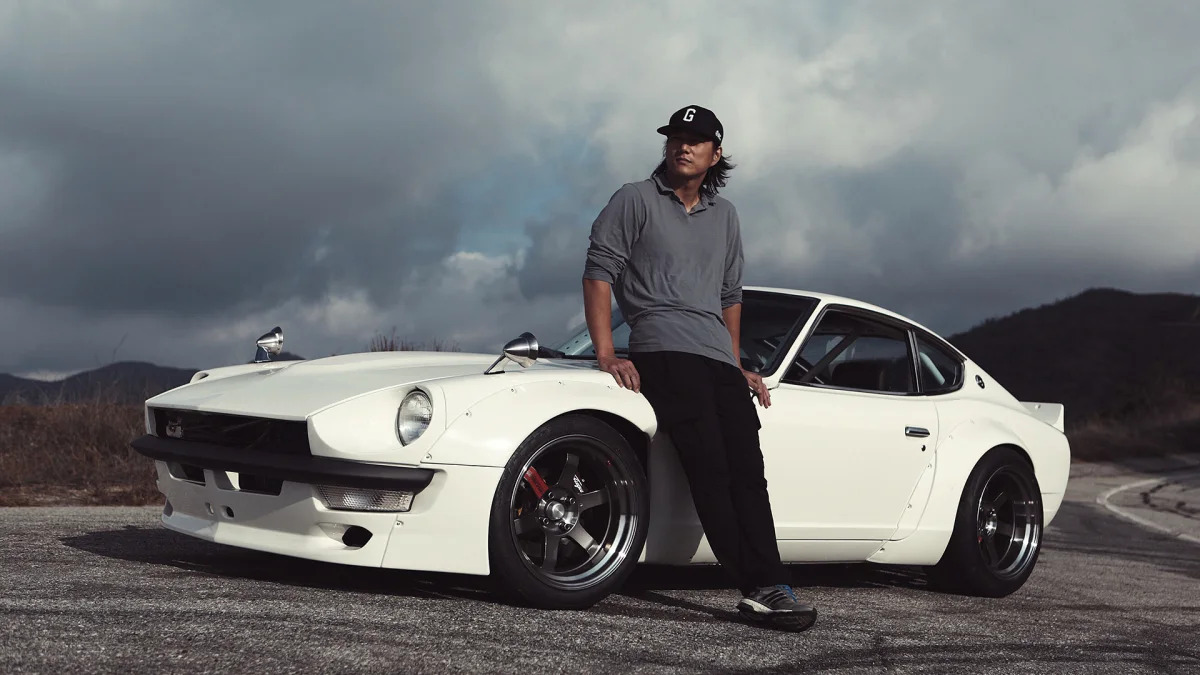









Sign in to post
Please sign in to leave a comment.
Continue